AleX James Hidell
by John ArmstrongThe first known use of the name "AleX James Hidell" was in the summer of 1963 at the Hotel Luma in Mexico City. Robert Clayton Buick had been hired by US intelligence to report on suspicious clandestine activities in Mexico City. Alex James Hidell, accompanied by a manager in the Luma Hotel, Franz Waehauf, and employee Warren Broglie, met and spoke with Robert Buick.
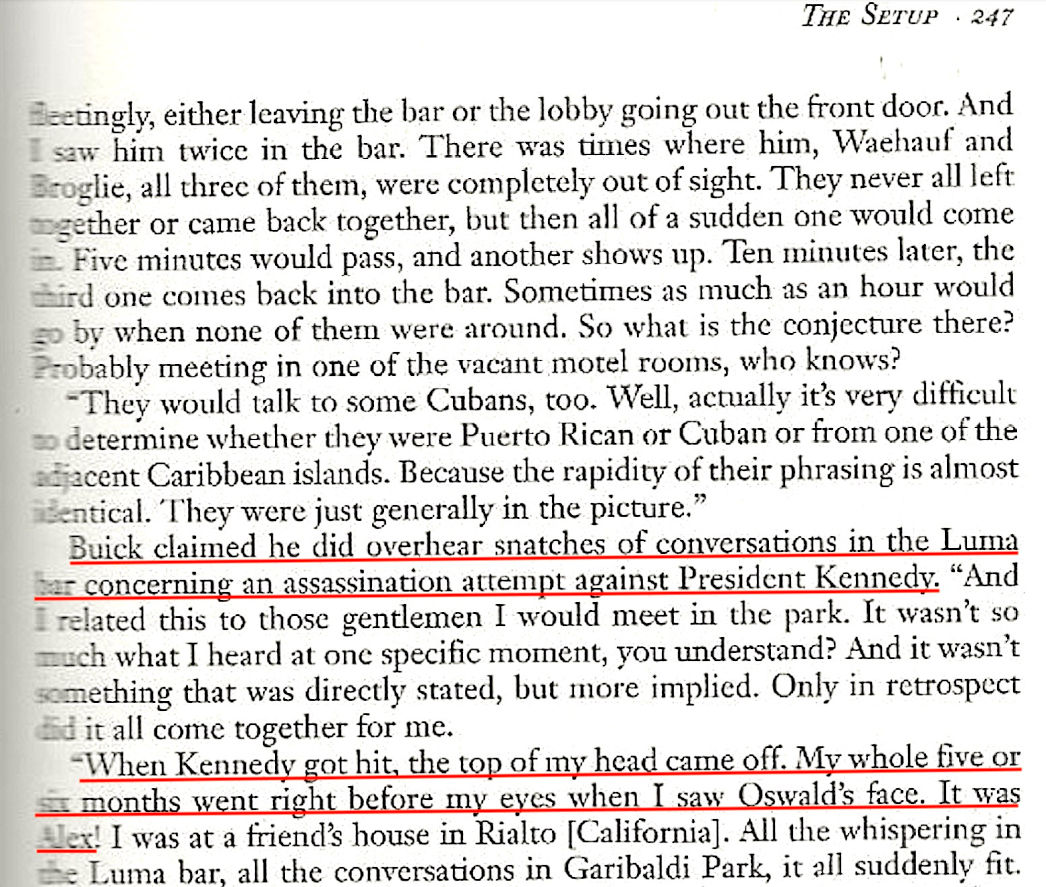
Buick told author Dick Russell that he heard
"snatches" of conversations in the Luma Bar concerning an assassination
attempt on President Kennedy. After President Kennedy was shot, and
Oswald's photo appeared on television, Buick instantly recognized him
as Alex James Hidell, the man he met and spoke with at the Hotel Luma
in Mexico City. It was LEE Oswald who met with Robert Buick in Mexico
City using the alias "AleX James Hidell." This may be the beginning of
LEE Oswald setting up HARVEY Oswald for the assassination of President
Kennedy. In the summer of 1963 Harvey Oswald and Marina were in New
Orleans, where Harvey Oswald was using the name "A. Hidell" in
connection with his FPCC activities. LEE Oswald, using his assigned
alias of "AleX Hidell," was involved in conversations wherein the
assassination of President Kennedy was discussed. On November 22, 1963
the name "A. Hidell" would connect HARVEY Oswald with discussions in
the Hotel Luma about the assassination of President Kennedy. The name
"A. Hidell" would also connect Harvey Oswald with the rifle found on
the 6th floor of the Book Depository. LEE Oswald using the alias "AleX
Hidell" and HARVEY Oswald using the alias "A. Hidell" and/or "AleK
Hidell" in the summer of 1963 was not a coincidence.
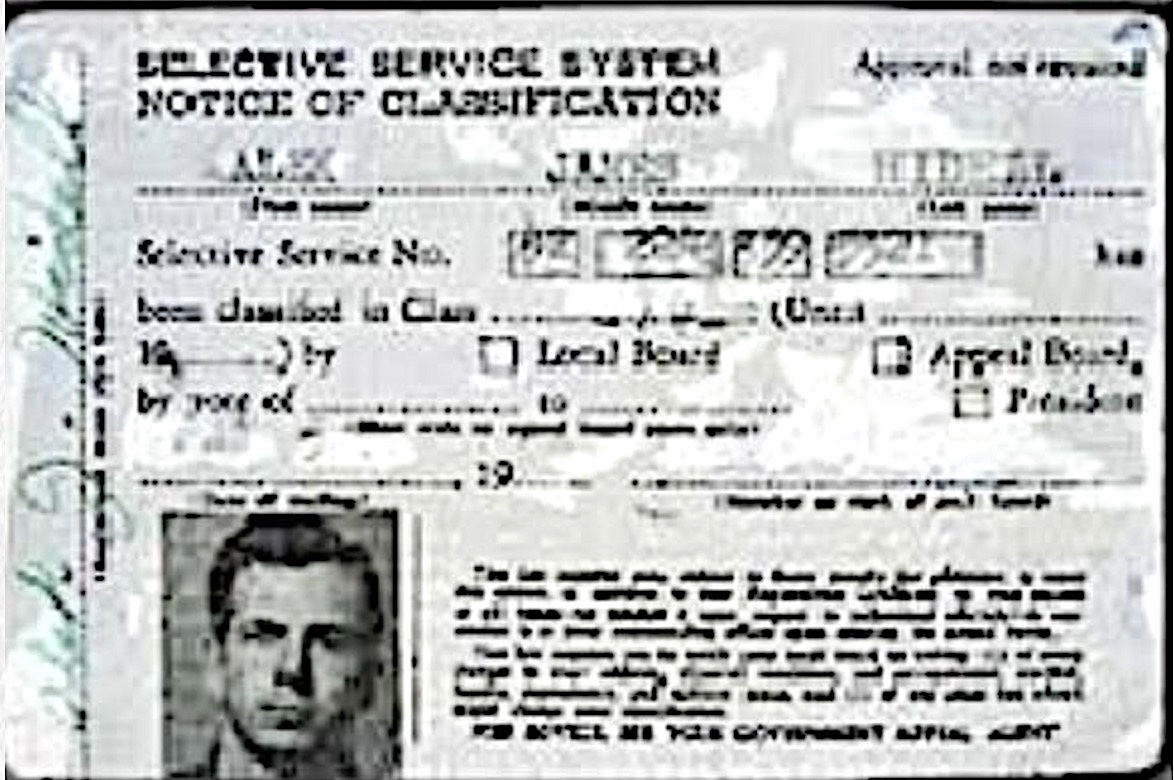
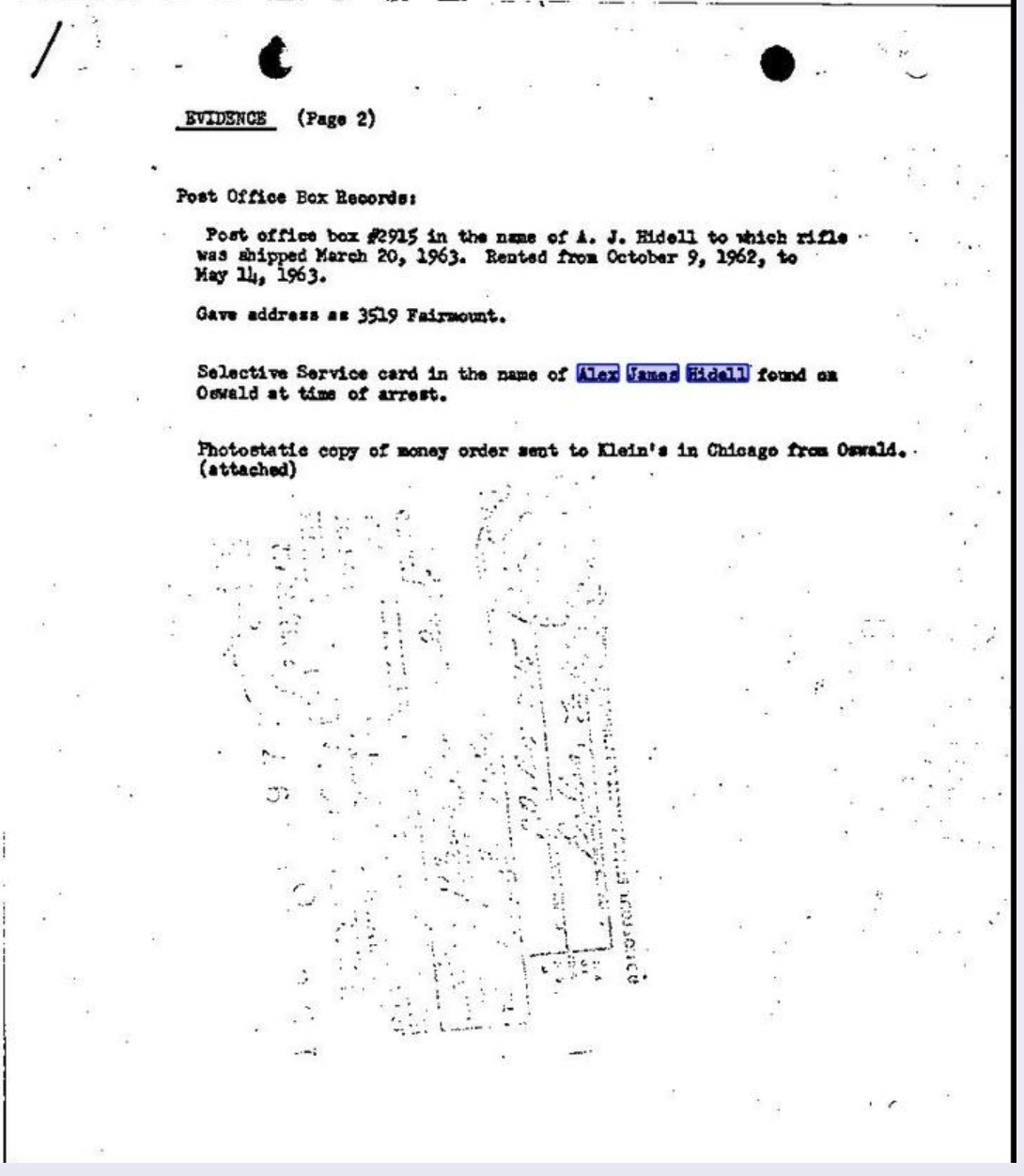


A fictitious Selective Service ID card, with the
name
AleX James Hidell, was one of the items in the 2nd Oswald wallet at
10th & Patton on November 22, 1963, when shown to fellow police
officers by DPD Capt. Westbrook. This AleX James Hidell ID card was
identified and described by the Dallas Police.
The earliest known use of the name "AleK James Hidell" was on the date of February 5, 1962, at least as indicated on the back side of the "ficticious" Selective Service System Notice of Classification card signed by Alek James Hidell.
AleK James Hidell
The earliest known use of the name "AleK James Hidell" was on the date of February 5, 1962, at least as indicated on the back side of the "ficticious" Selective Service System Notice of Classification card signed by Alek James Hidell.
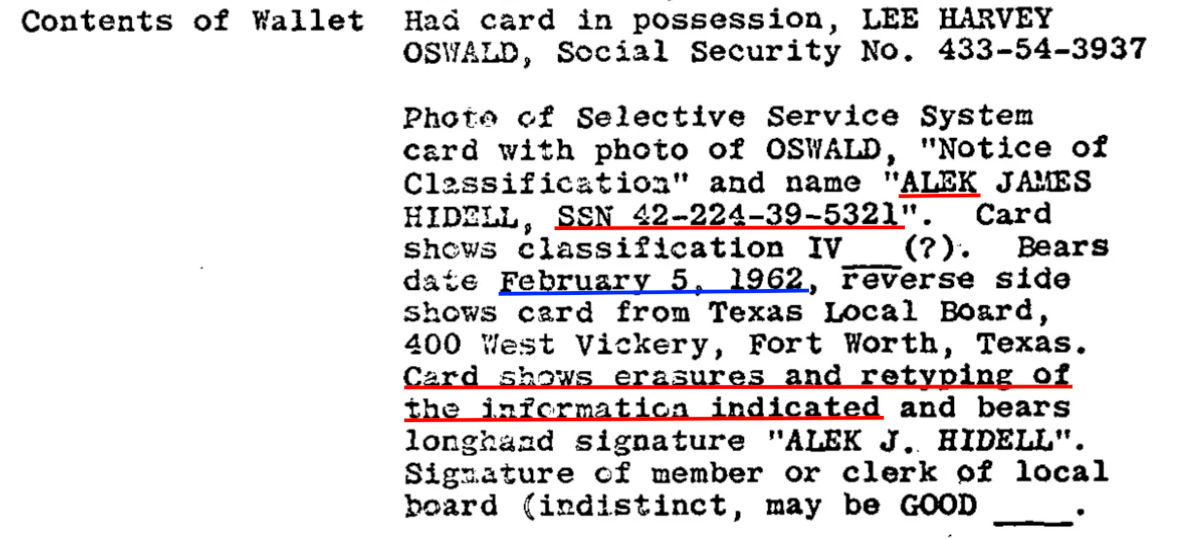
On February 5, 1962 (HARVEY) Oswald was in the
Soviet
Union. His nickname while in the Soviet Union was "Alik." Accordingly,
the CIA classification for HARVEY Lee Oswald was probably "Alek."
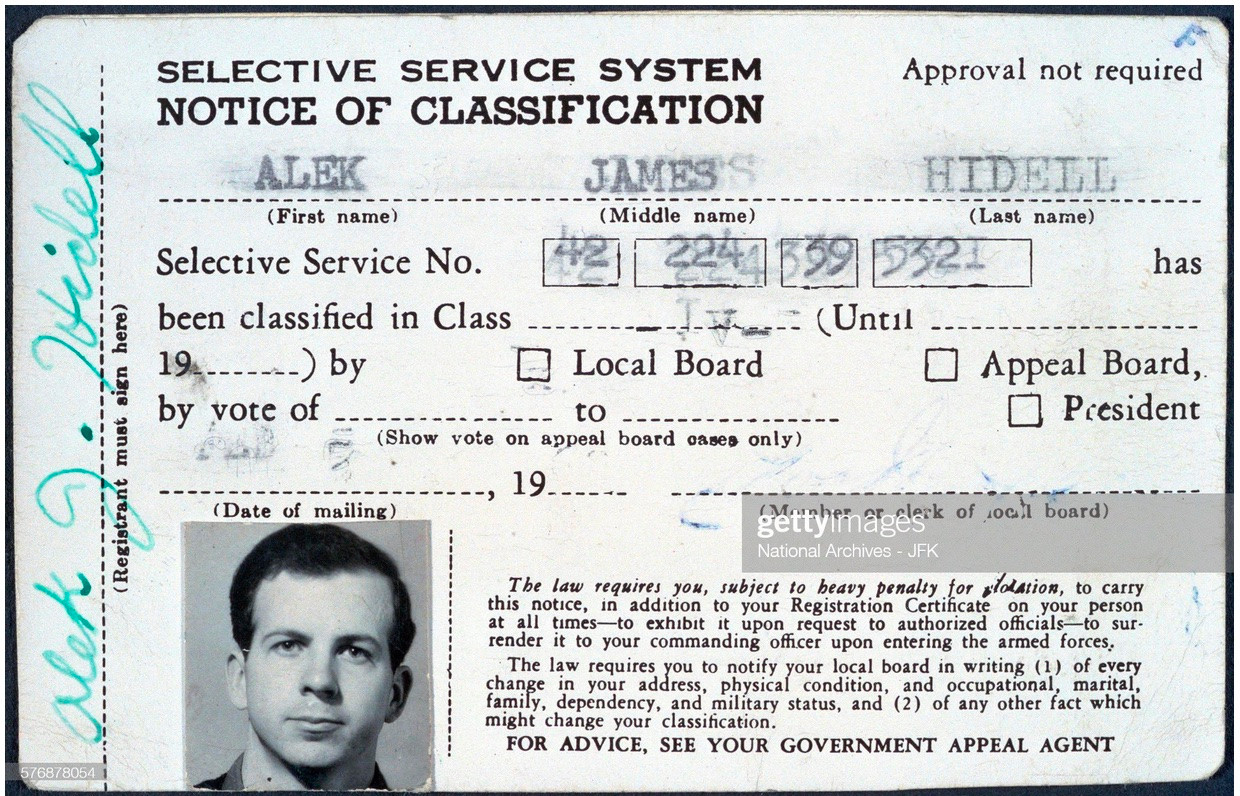
The next time we hear the name AleK James Hidell was around 1:42 PM on November 22, when DPD Capt. Westbrook showed the 2nd Oswald wallet to fellow police officers at the Tippit murder scene.
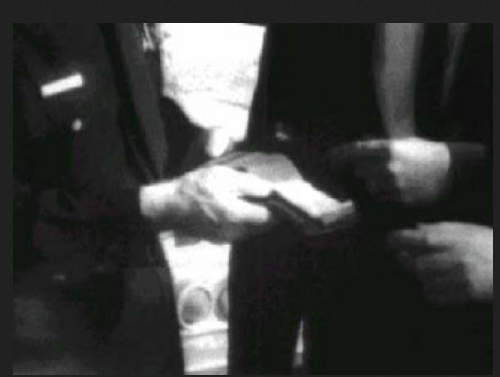
News reporter Ron Reiland photographed Capt, Doherty and Sgt. Owens as they examined the 2nd wallet. Westbrook then asked FBI agent Bob Barrett if he was familiar with the names "Alek/Alex James Hidell" or "Lee Harvey Oswald."
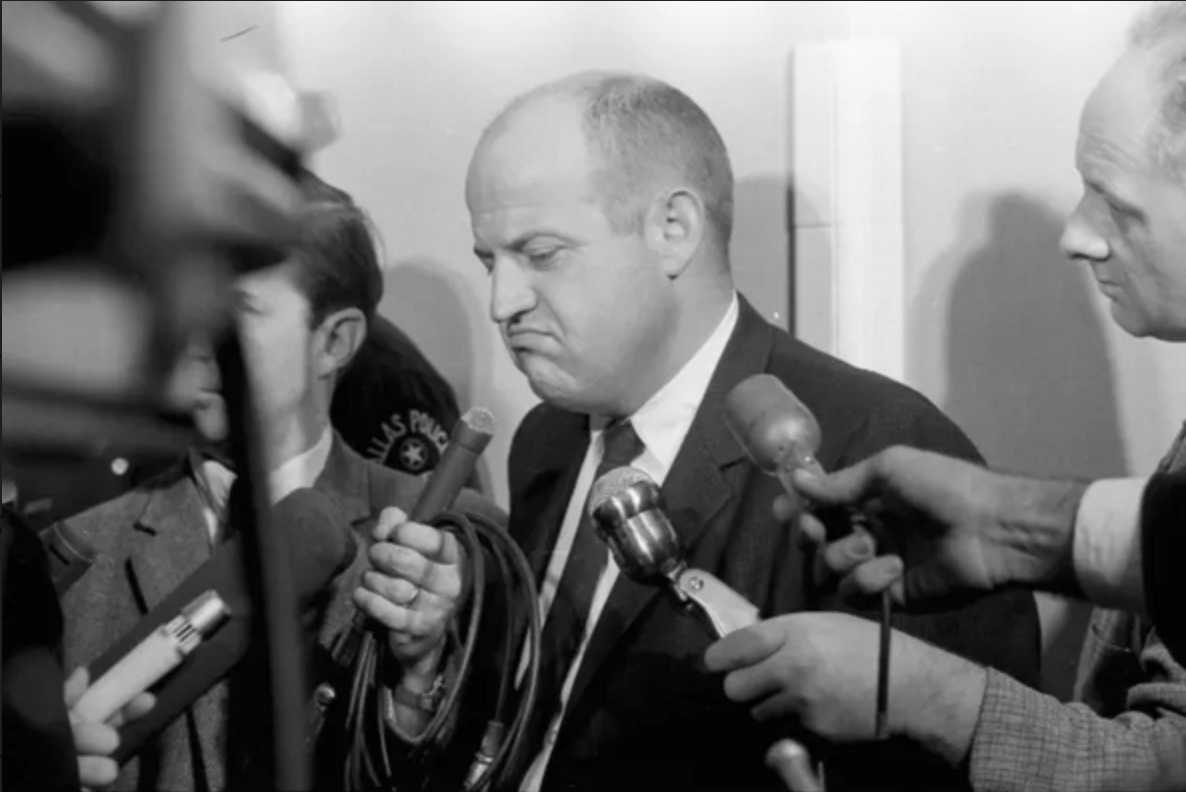
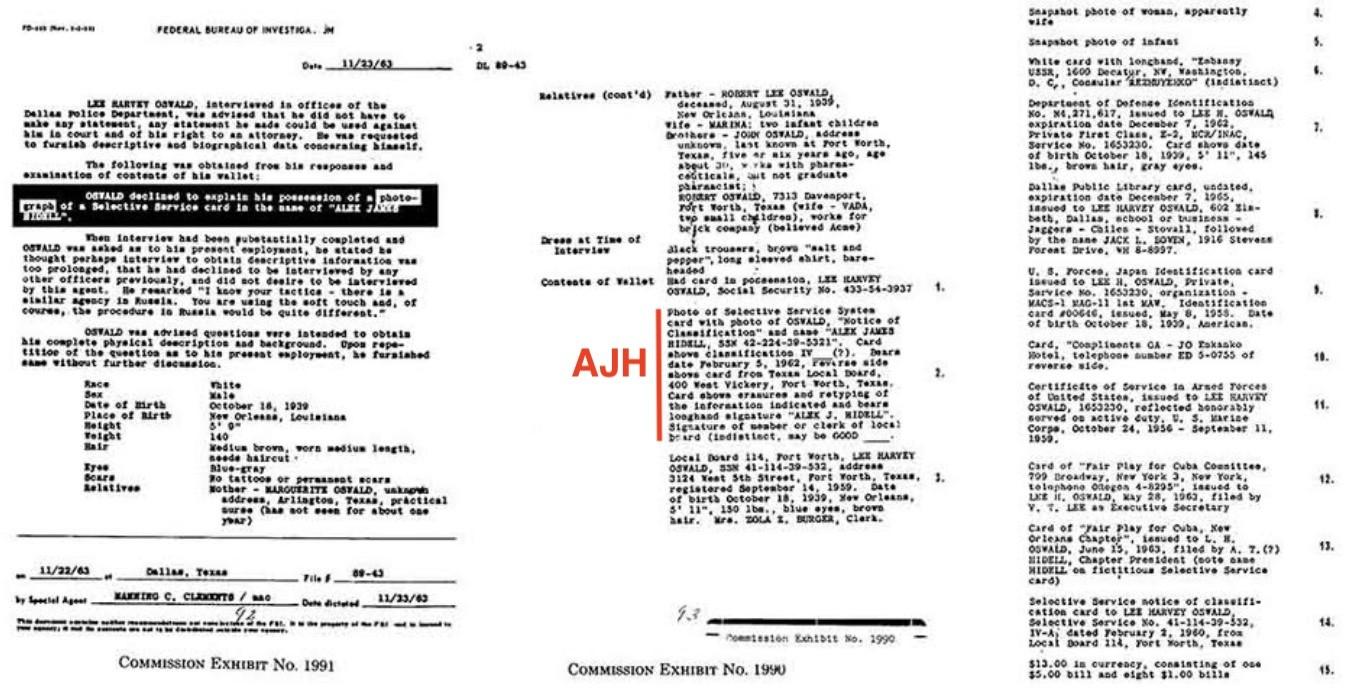

The next time we hear the name AleK James Hidell was around 1:42 PM on November 22, when DPD Capt. Westbrook showed the 2nd Oswald wallet to fellow police officers at the Tippit murder scene.

News reporter Ron Reiland photographed Capt, Doherty and Sgt. Owens as they examined the 2nd wallet. Westbrook then asked FBI agent Bob Barrett if he was familiar with the names "Alek/Alex James Hidell" or "Lee Harvey Oswald."

After Oswald was arrested, placed in Capt.
Westbrook's unmarked police car, and driven to police headquarters, the
name Alex or Alek James Hidell was not mentioned. Sgt. Gerry Hill was
interviewed by the press and said the suspect's name was Oswald ....
O-S-W-A-L-D.
Capt. Fritz began questioning Oswald around 2:30 PM, with Oswald's brown arrest wallet laying on Fritz's desk. The contents of Oswald's arrest wallet were not inventoried when he arrived at police headquarters.
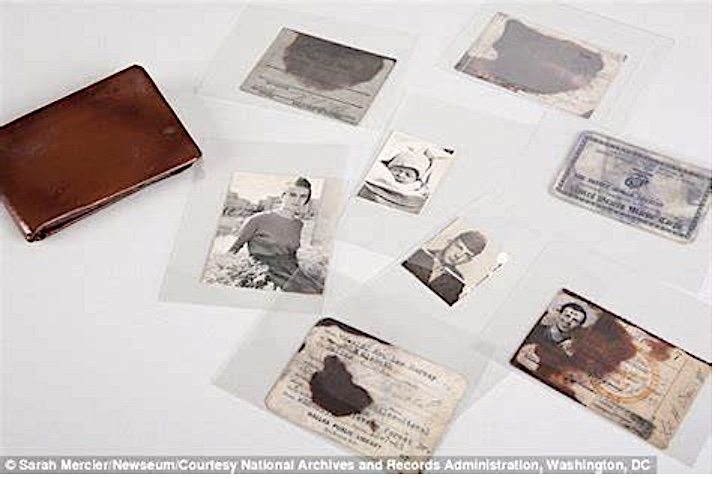
The National Archives made a photograph of Oswald's brown arrest wallet and the 8 original items found in his wallet.

Capt. Fritz began questioning Oswald around 2:30 PM, with Oswald's brown arrest wallet laying on Fritz's desk. The contents of Oswald's arrest wallet were not inventoried when he arrived at police headquarters.

The National Archives made a photograph of Oswald's brown arrest wallet and the 8 original items found in his wallet.

The FBI provided the Warren Commission with a list
of
8 items from Oswald's arrest wallet, shown above as CE 1989.
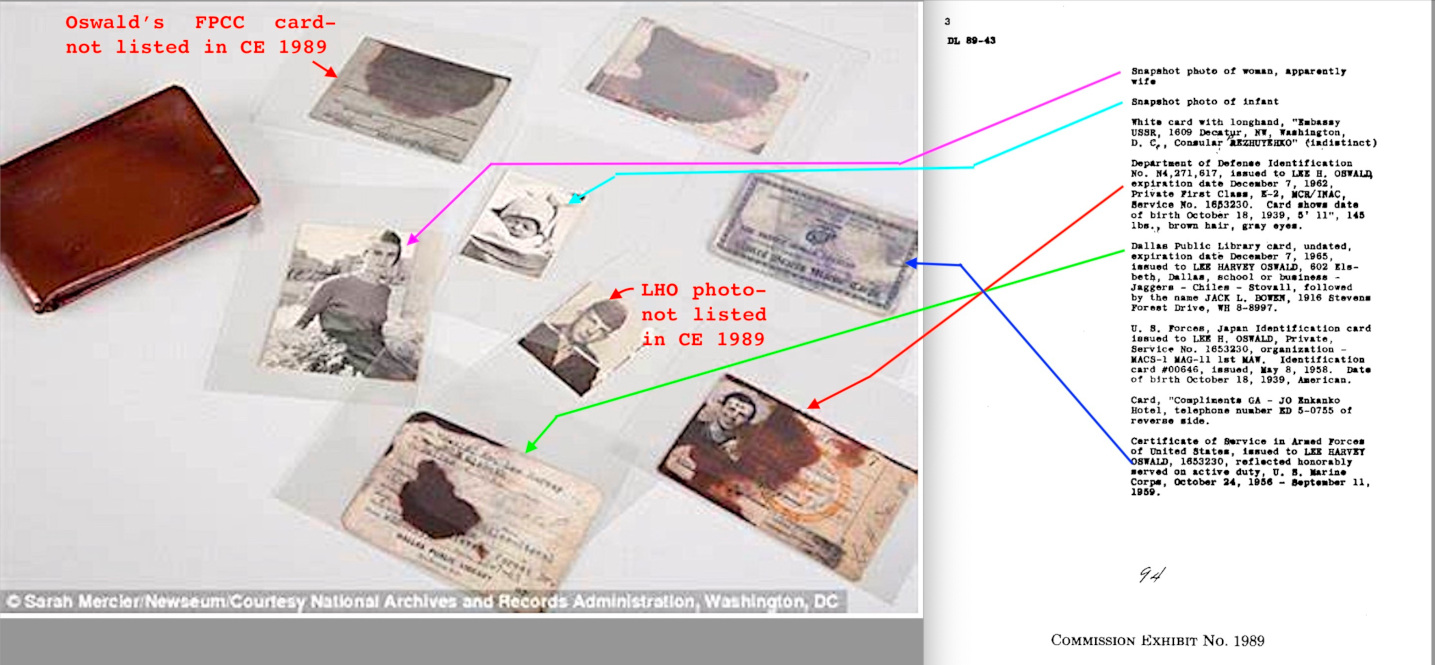

The National Archives and the FBI both listed 8
original items found in Oswald's arrest wallet. However, when placed
side by side the items of evidence are similar, but are not the same.
That evening, November 22, FBI agent James Bookhout suggested to FBI agent Manning Clements that he interview Oswald. Clements then asked and received permission from Capt. Fritz to interview Oswald (Clements briefly interviewed Oswald at 7:30 PM, 10:00 PM, and 11:30 PM).
That evening, November 22, FBI agent James Bookhout suggested to FBI agent Manning Clements that he interview Oswald. Clements then asked and received permission from Capt. Fritz to interview Oswald (Clements briefly interviewed Oswald at 7:30 PM, 10:00 PM, and 11:30 PM).

The 8 original items in Oswald's brown arrest
wallet,
in Dallas police headquarters at 2:00 PM on November 22, 1963, had
grown to 14 items when inspected and inventoried by FBI agent Manning
Clements at 10:00 PM. The addition of these "items of evidence" was
accomplished while Oswald's arrest wallet was in Capt. Fritz's office.
In Clements' FBI report he listed 14 items found in Oswald's wallet and
$13.00 in currency (item #15). He listed one AleK James Hidell ID card
with Oswald's photo, which is noted in his FBI report (above) with a
vertical line in red, and he listed 6 military type cards with the name
Lee Harvey Oswald. A total of 14 items, but only one AleK James
Hidell ID card. The AleX James Hidell card was not in Oswald's
arrest wallet at 10:00 PM on November 22, 1963.


The AleK James Hidell ID card, shown above, came
from
the 2nd Oswald wallet at 10th & Patton, which was last seen in the
possession of Capt. Westbrook. Eight hours later this card was
"discovered" in Oswald's brown arrest wallet by Agent Clements at 10:00
PM. Clements told the Warren Commission, "I recognized it as being a
fictitious card from the fact that the photograph was mounted on the
card, and that there were erasures in typing of information on the card
itself." This was likely the first and only time HARVEY Oswald saw the
AleK James Hidell ID card with his photo. Oswald now knew that someone
had put this card in his brown arrest wallet, but he didn't know why
and declined to discuss this card with agent Clements. Clements told
the Warren Commission that he showed Oswald the card but Oswald
"declined to answer any questions as to the reason of his possession of
it." The next morning, at 10:00 AM, Oswald was questioned by Capt.
Fritz, who asked him about the AleK James Hidell ID card. Inspector
Kelley wrote that Oswald refused to discuss the card.
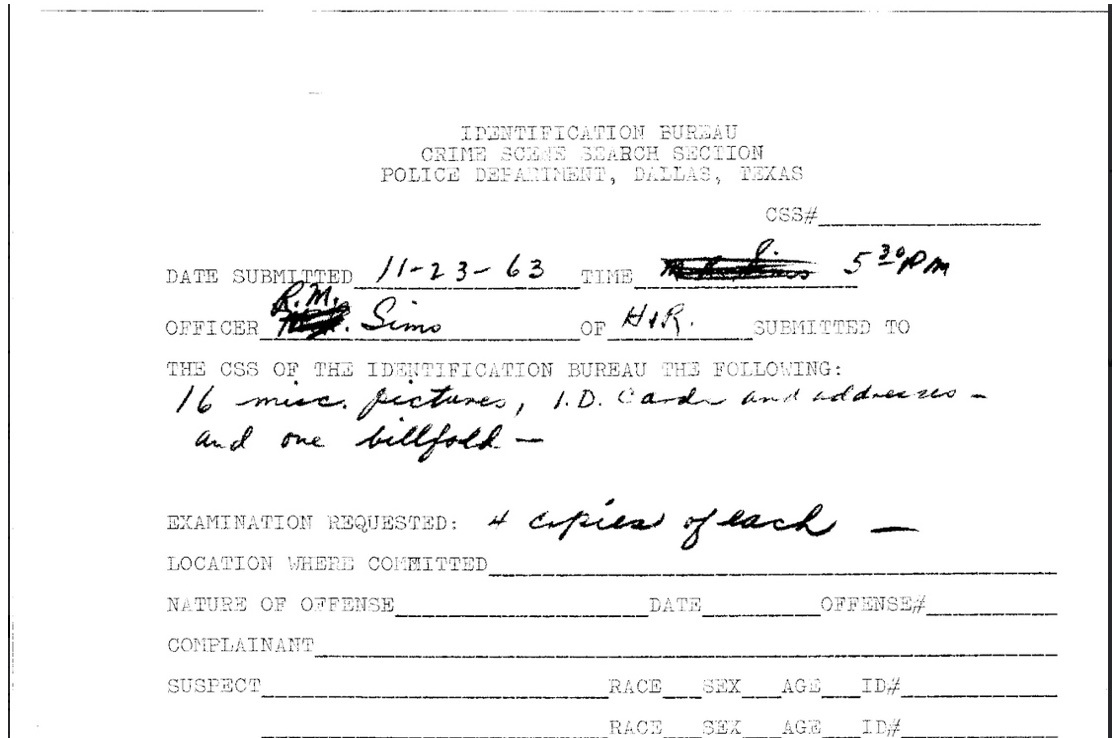
The next day (Saturday) two more items were added to Oswald's arrest wallet, bringing the total number of items to 16. At 5:30 PM (November 23rd) Det. Sims, who worked for Capt. Fritz, gave 16 items from Oswald's arrest wallet to J.B. Hicks and requested 4 photos of each item. Capt. Fritz sent 16 items of evidence to be photographed, but photographs of 17 items were returned to Capt. Fritz.


The next day (Saturday) two more items were added to Oswald's arrest wallet, bringing the total number of items to 16. At 5:30 PM (November 23rd) Det. Sims, who worked for Capt. Fritz, gave 16 items from Oswald's arrest wallet to J.B. Hicks and requested 4 photos of each item. Capt. Fritz sent 16 items of evidence to be photographed, but photographs of 17 items were returned to Capt. Fritz.

The following day, November 24, Fritz gave
photographs of 17 items to FBI agent James Bookhout, identified in the
FBI report above. Three items were added to the 14 items found by agent
Clements in Oswald's arrest wallet. The items added were 1) a snapshot
of Lee Harvey Oswald; 2) a Marine Corps Certificate of Service card
with the name AleK James Hidell; 3) a slip of paper with the name and
address of The Worker. This slip of paper connected HARVEY
Oswald to the person in the backyard photo holding a rifle in his right
hand and holding The Worker in his left hand. The total number
of items in Oswald's arrest wallet was now 17. A careful reading of the
list of items in Bookhout's report includes the AleK James Hidell card
(with photo attached) that was originally listed in Agent Manny
Clement's report of November 23, 1963. There is no mention of the
AleX James Hidell card in Bookhout's report. The whereabouts of the
AleX James Hidell ID card on November 24 is unknown and is not listed
on any FBI report.

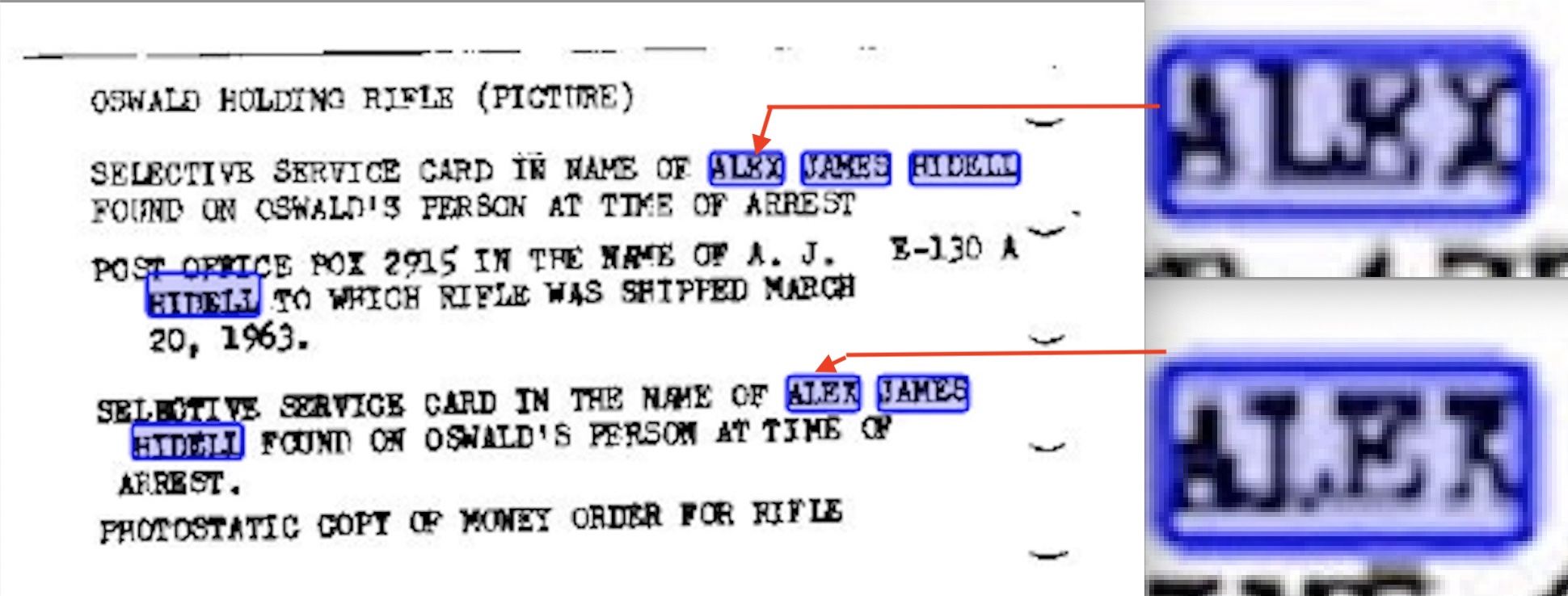
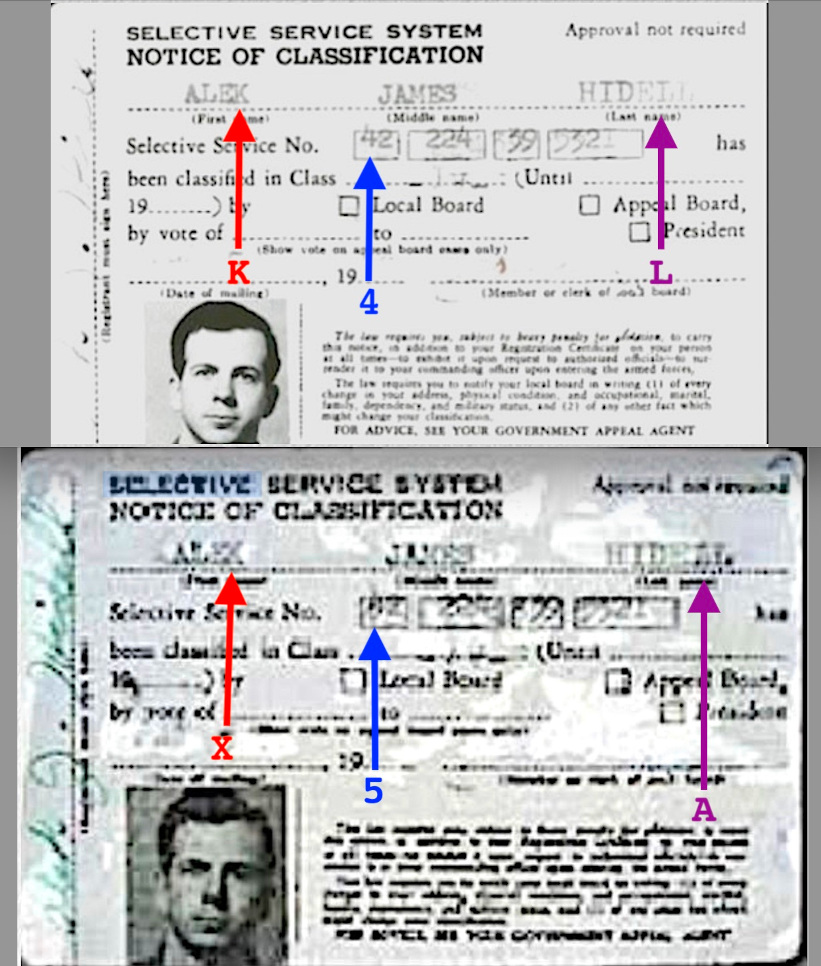

Four days later, on November 27, Capt. Fritz gave
FBI
agent James Hosty a total of 16 items from Oswald's wallet. One of the
items listed on Agent Bookhout's list of 17 items had been removed, but
there is no written inventory that would allow us to identify the
missing item. The missing item may have been the AleK James Hidell
ID card.
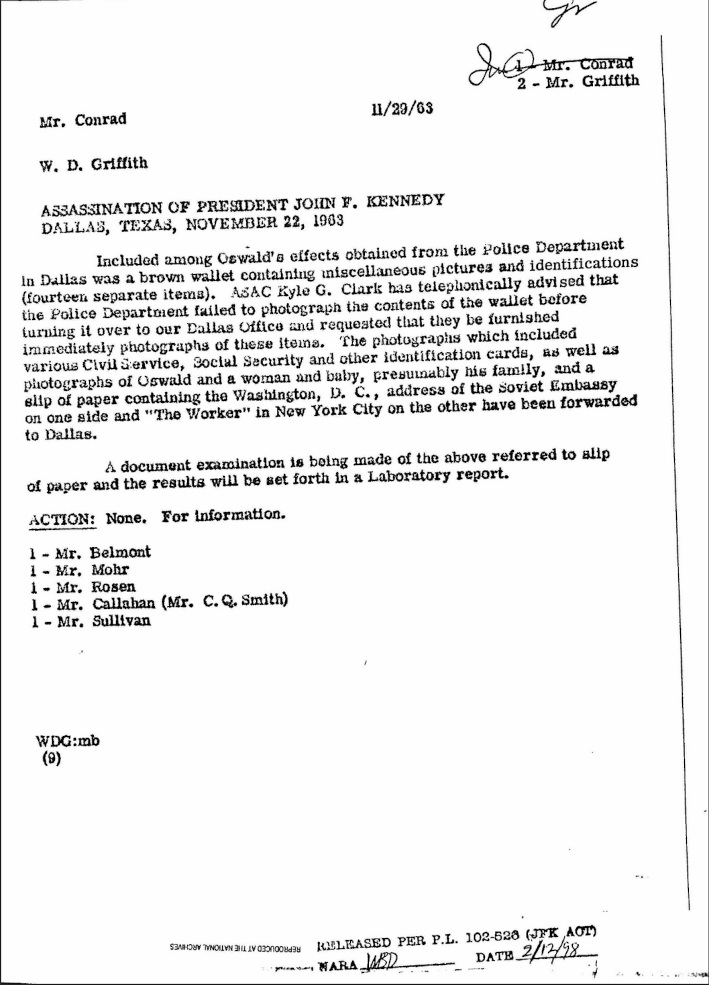

Two days later, on November 29, the FBI reported
they
received Oswald's brown arrest wallet and a total of 14 separate items
from the Dallas Police. This FBI memo claims the Dallas Police
Department "failed to photograph the contents of Oswald's wallet before
turning it over to the Dallas office," which was clearly not true. The
DPD gave FBI agent Hosty 16 items on November 27, but the FBI reported
receiving only 14 items. Two items are missing. It is worth
noting that in this FBI memo there is no mention whatsoever of the AleK
James Hidell ID card or the AleX James Hidell ID card. The two
missing items may be the AleK James Hidell and the AleX James Hidell ID
cards.
We know the Dallas Police had possession of both the AleK James Hidell ID card and the AleX James Hidell ID card. These cards came from the 2nd Oswald wallet at 10th & Patton and were last seen in the possession of Capt. Westbrook.
We know the Dallas Police had possession of both the AleK James Hidell ID card and the AleX James Hidell ID card. These cards came from the 2nd Oswald wallet at 10th & Patton and were last seen in the possession of Capt. Westbrook.

Both cards appear on records in the Dallas Police
Department, but only the AleK James Hidell card was found in Oswald's
wallet by Agent Manning Clements. The whereabouts of the AleX James
Hidell card and the 2nd Oswald wallet were unknown (the document above
is from the Dallas Police files, identified as jfk.2950).

When the "AleK James Hidell" card (upper) and the
"AleX James Hidell" card (lower) are shown together it is easy to see
these are two different cards.
The National Archives and the FBI both reported there were 8 items of original evidence in Oswald's brown arrest wallet. On the evening of November 22, FBI Agent Manning Clements made a list of 14 items he found in Oswald's arrest wallet. The most important item added to Oswald's arrest wallet was the AleK James Hidell ID card, and it was added by someone in the Dallas Police Department. The following day (November 23rd) two additional items were added to Oswald's arrest wallet, making a total of 16 items. Fritz sent these 16 items to be photographed, but when returned to Fritz there were now 17 items--another item of evidence had been added to Oswald's wallet. On November 24th FBI agent James Bookhout wrote, "Captain J.W. Fritz....furnished photographs of all of the articles contained in the wallet of Lee Harvey Oswald at the time of his arrest." Bookhout's report listed 17 items from Oswald's arrest wallet. Three days later, on November 27, Fritz gave 16 items to FBI Agent James Hosty. On November 29 an FBI memo reported receiving 14 items of evidence and a brown wallet from the Dallas Police.
The way the evidence in Oswald's arrest wallet was continuously altered almost seems comic, except for the fact that it was done for a deadly serious purpose--for the purpose of framing Oswald for two murders of which he was innocent. It is now clear that, while in Capt. Fritz's office, items of evidence were added and deleted from Oswald's brown arrest wallet. The reader, however, should also understand the importance of Mexico City as a staging area for the framing of Harvey Oswald in the assassination of President Kennedy. Heretofore, the emphasis has been placed on the alleged visits of Oswald to the Cuban and Soviet embassies, but there are indications that LEE Oswald had been in Mexico on multiple occasions.
Earlier in this article, it was shown that the first known use of the alias “AleX James Hidell” was at the Hotel Luma in Mexico City during the summer of 1963. The man who used the alias was almost certainly LEE Oswald, who was beginning his pattern of framing HARVEY Oswald for the upcoming assassination of JFK. As opposed to HARVEY, there is evidence that LEE had been to Mexico on at least several occasions.
In the fall of 1962 Donald P. Norton was given a case full of money by his CIA contact and told to travel to Monterrey, Mexico and meet "Harvey Lee." Norton took the case, traveled to Monterrey as directed, and checked into the Yamajel Hotel. Before Norton was able to get to his room he was met by "Harvey Lee." The two men went into the hotel bar to drink a couple of beers and relax. Norton recalled that "Harvey Lee" refused to look him in the eye and said that he was from New Orleans. When Norton saw photographs of "Lee Harvey Oswald" in the newspaper following the assassination, he said the man was identical to the "Harvey Lee" he met in Monterrey, except that his hair appeared to be thinner. Norton delivered the case full of money to "Harvey Lee" and was given a briefcase full of documents in return. Norton took the documents and drove, as instructed, to Calgary in Alberta, Canada. Norton gave the documents to his contact and then left. He then telephoned Mr. Albert Penn, another of his CIA contacts in Five Points, Alabama. Penn instructed Norton to proceed to Boston, Mass, which he did. Norton was questioned and interviewed by Jim Garrison.
In August, 1963, with Harvey and Marina living at 4905 Magazine Street in New Orleans, LEE Oswald arrived at Cliff Shasteen's barbershop in Irving, Texas at 6:30 am for a haircut. Shasteen, a 39-year-old barber and Irving City Council member, remembered the visit because Oswald was wearing shoes which were "out of the ordinary." He commented to Oswald that the shoes, which were brilliant yellow and embossed with a design, must be expensive. Oswald said, "No, not where I bought them," and explained that he had purchased the shoes in Old Mexico for $1.50. Shasteen remarked, "Man, I' d like to have a pair of them because I have to wear a shoe built-up." Oswald replied, "Well, I'll get you a pair the next time I'm down there." Oswald told Shasteen, "I make lots of trips down there."
The incident at the Hotel Luma in mid-summer, 1963, was a clever ploy created for the purpose of showing (HARVEY) Oswald discussing the assassination of President Kennedy. Lee Oswald, using the alias "AleX James Hidell, was being used to set up Harvey as a "patsy." This demonstrates and reveals the actual workings of the framing of (HARVEY) Oswald by LEE Oswald, who was using the alias "AleX James Hidell." At the same time HARVEY Oswald, living in New Orleans, was using the alias "A. J. Hidell" on his FPCC activities. During this time David Atlee Phllips was working at the Mexico City station of the CIA. According to his colleague, Winston Scott, Phillips' "comprehensive understanding of human beings combined with a thorough knowledge of covert action techniques and his fluent Spanish make him unusually valuable." Oswald, according to several accounts, was either working for or closely associated with the CIA. Therefore, it is reasonable to wonder if the name "AleK" was an alias used by HARVEY Oswald (first in the Soviet Union, then in Mexico City) while at the same time the name "AleX" (Hotel Luma) was an alias used by LEE Oswald. This would allow the CIA to monitor and follow the activities and whereabouts of both Harvey and Lee without exposing their true identities. This would also explain why there was an ID card with the name AleX Hidell and an ID card with the name AleK Hidell. The existing evidence points to Phillips exploring myriad ways of creating a false narrative of Oswald's nefarious purposes in the phony trip to Mexico City. The use of the identification cards of AleX Hidell and AleK Hidell is a perfect example of Phillips' stock-in-trade: misdirection and slight-of-hand in order to link Oswald to the mail order rifle that killed JFK. The conspirators, not Oswald, created these "fictitious" cards with erasures, spelling changes, and a photo of (HARVEY) Oswald attached. It was essential that these cards appeared to be "fictitious," because if they were created skillfully it might be perceived that Oswald was an actual intel operative. By creating "fictitious" cards, the spin that could be placed was that Oswald himself was the creator of the cards and he was living in a fantasy world by engaging in spy games. While the process may have been messy in switching the two ID cards from the 2nd Oswald wallet to HARVEY Oswald's arrest wallet in Capt. Fritz's office, the result was precisely what Phillips intended to achieve: the assigning of guilt to HARVEY Oswald, who fancied himself as a "spy" and the confusion that would await investigators and researchers to make sense of the two names AleX Hidell and AleK Hidell.
Investigators and researchers have been trying to make sense of AleX and AleK Hidell for decades. Even today, 60 years later, when searching the internet for a Selective Service card in the name of AleX James Hidell on Google, the only result is the name "AleK James Hidell." Phillips' misdirection and slight-of-hand concerning the use of the aliases AleX Hidell and AleK Hidell continues to confuse researchers.
The National Archives and the FBI both reported there were 8 items of original evidence in Oswald's brown arrest wallet. On the evening of November 22, FBI Agent Manning Clements made a list of 14 items he found in Oswald's arrest wallet. The most important item added to Oswald's arrest wallet was the AleK James Hidell ID card, and it was added by someone in the Dallas Police Department. The following day (November 23rd) two additional items were added to Oswald's arrest wallet, making a total of 16 items. Fritz sent these 16 items to be photographed, but when returned to Fritz there were now 17 items--another item of evidence had been added to Oswald's wallet. On November 24th FBI agent James Bookhout wrote, "Captain J.W. Fritz....furnished photographs of all of the articles contained in the wallet of Lee Harvey Oswald at the time of his arrest." Bookhout's report listed 17 items from Oswald's arrest wallet. Three days later, on November 27, Fritz gave 16 items to FBI Agent James Hosty. On November 29 an FBI memo reported receiving 14 items of evidence and a brown wallet from the Dallas Police.
The way the evidence in Oswald's arrest wallet was continuously altered almost seems comic, except for the fact that it was done for a deadly serious purpose--for the purpose of framing Oswald for two murders of which he was innocent. It is now clear that, while in Capt. Fritz's office, items of evidence were added and deleted from Oswald's brown arrest wallet. The reader, however, should also understand the importance of Mexico City as a staging area for the framing of Harvey Oswald in the assassination of President Kennedy. Heretofore, the emphasis has been placed on the alleged visits of Oswald to the Cuban and Soviet embassies, but there are indications that LEE Oswald had been in Mexico on multiple occasions.
Earlier in this article, it was shown that the first known use of the alias “AleX James Hidell” was at the Hotel Luma in Mexico City during the summer of 1963. The man who used the alias was almost certainly LEE Oswald, who was beginning his pattern of framing HARVEY Oswald for the upcoming assassination of JFK. As opposed to HARVEY, there is evidence that LEE had been to Mexico on at least several occasions.
In the fall of 1962 Donald P. Norton was given a case full of money by his CIA contact and told to travel to Monterrey, Mexico and meet "Harvey Lee." Norton took the case, traveled to Monterrey as directed, and checked into the Yamajel Hotel. Before Norton was able to get to his room he was met by "Harvey Lee." The two men went into the hotel bar to drink a couple of beers and relax. Norton recalled that "Harvey Lee" refused to look him in the eye and said that he was from New Orleans. When Norton saw photographs of "Lee Harvey Oswald" in the newspaper following the assassination, he said the man was identical to the "Harvey Lee" he met in Monterrey, except that his hair appeared to be thinner. Norton delivered the case full of money to "Harvey Lee" and was given a briefcase full of documents in return. Norton took the documents and drove, as instructed, to Calgary in Alberta, Canada. Norton gave the documents to his contact and then left. He then telephoned Mr. Albert Penn, another of his CIA contacts in Five Points, Alabama. Penn instructed Norton to proceed to Boston, Mass, which he did. Norton was questioned and interviewed by Jim Garrison.
In August, 1963, with Harvey and Marina living at 4905 Magazine Street in New Orleans, LEE Oswald arrived at Cliff Shasteen's barbershop in Irving, Texas at 6:30 am for a haircut. Shasteen, a 39-year-old barber and Irving City Council member, remembered the visit because Oswald was wearing shoes which were "out of the ordinary." He commented to Oswald that the shoes, which were brilliant yellow and embossed with a design, must be expensive. Oswald said, "No, not where I bought them," and explained that he had purchased the shoes in Old Mexico for $1.50. Shasteen remarked, "Man, I' d like to have a pair of them because I have to wear a shoe built-up." Oswald replied, "Well, I'll get you a pair the next time I'm down there." Oswald told Shasteen, "I make lots of trips down there."
The incident at the Hotel Luma in mid-summer, 1963, was a clever ploy created for the purpose of showing (HARVEY) Oswald discussing the assassination of President Kennedy. Lee Oswald, using the alias "AleX James Hidell, was being used to set up Harvey as a "patsy." This demonstrates and reveals the actual workings of the framing of (HARVEY) Oswald by LEE Oswald, who was using the alias "AleX James Hidell." At the same time HARVEY Oswald, living in New Orleans, was using the alias "A. J. Hidell" on his FPCC activities. During this time David Atlee Phllips was working at the Mexico City station of the CIA. According to his colleague, Winston Scott, Phillips' "comprehensive understanding of human beings combined with a thorough knowledge of covert action techniques and his fluent Spanish make him unusually valuable." Oswald, according to several accounts, was either working for or closely associated with the CIA. Therefore, it is reasonable to wonder if the name "AleK" was an alias used by HARVEY Oswald (first in the Soviet Union, then in Mexico City) while at the same time the name "AleX" (Hotel Luma) was an alias used by LEE Oswald. This would allow the CIA to monitor and follow the activities and whereabouts of both Harvey and Lee without exposing their true identities. This would also explain why there was an ID card with the name AleX Hidell and an ID card with the name AleK Hidell. The existing evidence points to Phillips exploring myriad ways of creating a false narrative of Oswald's nefarious purposes in the phony trip to Mexico City. The use of the identification cards of AleX Hidell and AleK Hidell is a perfect example of Phillips' stock-in-trade: misdirection and slight-of-hand in order to link Oswald to the mail order rifle that killed JFK. The conspirators, not Oswald, created these "fictitious" cards with erasures, spelling changes, and a photo of (HARVEY) Oswald attached. It was essential that these cards appeared to be "fictitious," because if they were created skillfully it might be perceived that Oswald was an actual intel operative. By creating "fictitious" cards, the spin that could be placed was that Oswald himself was the creator of the cards and he was living in a fantasy world by engaging in spy games. While the process may have been messy in switching the two ID cards from the 2nd Oswald wallet to HARVEY Oswald's arrest wallet in Capt. Fritz's office, the result was precisely what Phillips intended to achieve: the assigning of guilt to HARVEY Oswald, who fancied himself as a "spy" and the confusion that would await investigators and researchers to make sense of the two names AleX Hidell and AleK Hidell.
Investigators and researchers have been trying to make sense of AleX and AleK Hidell for decades. Even today, 60 years later, when searching the internet for a Selective Service card in the name of AleX James Hidell on Google, the only result is the name "AleK James Hidell." Phillips' misdirection and slight-of-hand concerning the use of the aliases AleX Hidell and AleK Hidell continues to confuse researchers.